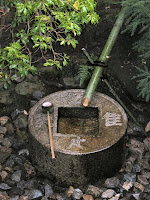On my last night in town I dined on delicate Kyoto cuisine with my old girlfriend Naomi, visited a master shiatsu massage therapist for work my bruised (cracked?) ribs, and ended the evening drinking beer at Hachimonjiya, a retro-70's counter-culture bar in the Kiyamachi nightlife district.
The bruised (cracked?) ribs I sustained in an incident at an enchanted garden, one that is so exalted it is rarely open to the public. I was minding my own business when I tripped on a stepping stone and rammed face forward into a tree then spun around and crashed sideways into a priceless stone basin called a tsukubai. Luckily, the polycarbonite lenses on my glasses saved my right eye and the bamboo implements atop the tsukubai were not damaged by my fall, otherwise I'd have to sell my house.
 Hachimonjiya is a smoke-filled hole-in-the-wall joint on the 3rd floor of an unassuming building off the splenid Kiyamachi canal. It's a fire trap jammed with stacks of old books and magazines and patronized by scraggly chain-smoling bohemians. I met a jazz saxophonist and an unemployed movie sound engineer. The owner is a Kyoto photographer named Kai Fusayoshi who was absent that night because he was in Paris for an exhibition of his work.
Hachimonjiya is a smoke-filled hole-in-the-wall joint on the 3rd floor of an unassuming building off the splenid Kiyamachi canal. It's a fire trap jammed with stacks of old books and magazines and patronized by scraggly chain-smoling bohemians. I met a jazz saxophonist and an unemployed movie sound engineer. The owner is a Kyoto photographer named Kai Fusayoshi who was absent that night because he was in Paris for an exhibition of his work.
Kai is also one of the founders (in 1972) of Honyarado, the iconic coffee house and woodsy hotbed of folk music, poets and political activists. Honyarado was empty when I dropped by for coffee. Activist posters and handbills were plastered on the walls and a soundtrack of early Bob Dillon filled the air - reassuringly frozen in time.
For a feel of what folk-rock music was like in Japan during early 1970s, well before J-Pop rock schlock, click on the following link. Originally I had a link to a great video featuring middle aged Haruomi Hosono and his Happy End (はっぴえんど) band mates performing live the iconic Natsu Nandesu, but it disappeared from YouTube. This click sends you t an audio file dressed up with photos of the album cover. Best I can do. The song is a nostalgic portrait of a neighborhood in Tokyo, not Kyoto, but it gives you the feeling of the lost era.
Natsu Nandesu
(hit the left arrow to return to the blog)

.JPG)

No comments:
Post a Comment